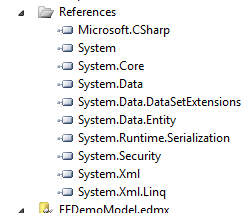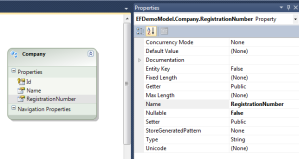In the previous post we looked at the architecture of the Entity Framework. Carrying on from there we will see how to setup a basic Model First Design Scenario.
Common Tasks
For any operation against the Entity Framework, you will need to instantiate a data context. Since this object is bound to external resources it is important to clean it up after use. Wrapping the instantiation in a “using” block should take care of this.
A Simple Designer Scenario
Is this example we will add an entity to the designer in model first mode. We can then add some properties. We will also run through some of the options available to you as we go.
It is a good idea to keep all your EF Models in a class library off your main project. This will afford you the opportunity to reuse the model between multiple projects.
To add a EF Model
- Right click the project -> Add New Item
- Select ADO .NET Entity Data Model
- Give your model a name
- Select “Empty Model” from the wizard
This will create an EDMX file and add it to your project. You will also notice some references being added to the project.
You should now be presented with the designer surface. Selecting the design surface, explore the properties of the data context but hitting F4
Lets run through some of the more interesting properties here, bearing in mind that we are going to model first then generate our database off the model. This means we need to provide Entity Framework with some working knowledge about our database.
- Code Generation Strategy: Allows us to use our own T4 templates for code generation.
- Connection String: Notice this is blanked out, this will be populated once we bind the model to a database.
- Database Schema Name: Notice in this image it is bold, meaning it has been changed. The default is “dbo”, however it is convenient to partition off your system areas. This will add every generated entity in the model to the database schema specified.
- Lazy Load Enabled: This allows us to use deferred loading of entities.
- Metadata Artifact Processing: We will go into this in more detail, but for now we can say it relates to the special way entity framework handles its connection strings.
- Namespace: This is the code namespace the model will be stored under
- Pluralize New Objects: This tries to cleverly pluralize the entity collections and database object names. So Company would have a collection name of Companies.
- Transform Related Text Template on Save: This specifies whether to invoke the T4 code generation when the EDMX is saved.
- Validate on Build: Verifies that the model is valid and there is no unbound entities or properties.
Once we are happy with the data context we can begin creating entities. We can either drag an entity from the toolbox onto the design surface, or we can use the context menus from the design surface. Either method is fine, but the context menu gives you a net dialog to full out: right click -> Add -> Entity…
- Properties
- Entity Name: The name of your entity (singular)
- Base Type: Relates to inheritance, which we will cover later on.
- Entity Set: The collection name for your entity, this get auto populated but you can change it if you feel the need.
- Key Property
- Create Key Property: Tell the designer to create a property the entity can key off. Every entity MUST have a key. Composite keys can be defined later in the designer.
- Property Name and Property Type: If generating a single primary key, you can set the type and name of it here
Once the entity has been created we can start adding properties to it. Right click on the properties section in the entity -> Add -> Scalar. Give your property a name. You can get more detail on your property by hitting F4 while it is selected:
Here I have created a Company entity and given it a few properties. Inspecting one of these we see:
- Concurrency Mode: If set, this property will for part of the update statement generated along with the primary key. This is similar to the concurrency model in the old DataAdapters, except you have much finer control in the Entity Framework. By way of example, lets look at two SQL statements:
A) No Concurrency Control:
UPDATE Company SET RegistrationNumber = ‘9999’ WHERE Id = 3
B) With Concurrency Control:
UPDATE Company SET RegistrationNumber = ‘9999’ WHERE Id = 3 AND RegistrationNumber = ‘123’
In example A there is no guarantee that the record has not been modified since we read it. The only way we could detect a concurrency issue is if the row was deleted in which case the ROWS AFFECTED will return 0.
In the example B, because the original value/s of the row participates in locating the record, we can now detect if a concurrency violation has taken place since out last read, i.e.: The record has been changed, since no match will be made. If ROWS AFFECTED returns 0, a concurrency exception is thrown, and the application must offer up some form of conflict resolution.
- Default Value: This is the default code value. Note: This does NOT set the database default value for a property. It will only initialize the objects property value.
- Entity Key: Specifies whether this property participates in the entities key.
- Fixed Length: This is for database generation, will make the property either varchar of char if a string.
- Max Length: This is for database generation, will set the field length in the database.
- Nullable: Affects both the entity and the database object.
- StoreGeneratedPattern: Allows the database to set the value of this property, this is primarily used for auto increment values.
- Type: the CLR type of this property
- Unicode: if the type is a string, specifies whether the property supports an extended character set (nvarchar vs varchar)
We now have a basic entity model to query. Although at this stage it is not bound to a database
Querying
LinQ to Entities
Since the Entity Framework supports the Linq query interface we have all the Linq commands available to us. The following link provides several querying examples that should cover most development scenarios.
http://msdn.microsoft.com/en-us/vcsharp/aa336746.aspx
It is important to note however that it is never a good idea to have overly complicated database queries in a Linq statement, lest we lose SQL pre-compilation optimizations, instead for this it is probably better to wrap the query logic in a stored proc and expose it via the entity framework. Here is an example of a simple query layout that one might find in a service class that handles paging.
Some things to note here:
- The data context instance is wrapped in a using statement so it is nicely cleaned up after use.
- We ToList() the query, in essence what this does is execute the query and enumerate the results into a List object.
Lazy Loading
Entity framework supports deferred loading, that is, a query will not be executed unless it is used via iteration or other operation. This gives us the ability to logically supplement the query as we pass it through our code. We could also create a base query (say limit the results to the current user ID) and then build upon this. Lazy loading may be switched on an off via the DataContext.
Loading a Network Graph
It is also possible when querying an entity to return all related entities via a navigation property. In this case we instruct the data context to also load a “path”. This will load the queried entities as well as all related entities in the graph. This is a useful for caching or master / detail scenarios. We do this by querying using lambda expressions queries off the data context collection using the “Include” method:
Context.Companies.Include(“Employees”).Select(x => x.Name == “My Start-up”);
In this example we load the company “My Start-up” and all its Employees.
Loading from Inheritance
It is possible to define an inheritance relationship between entities (covered later on). However when querying, it is important to note that principles of polymorphism apply. When querying a base type, all sub types that match the base type query are returned too. Although returned as an enumeration of the base type, the underlying CLR type that they will be instantiated as is the sub type. This has some profound implications on the data loading from SQL too. Any properties that extend the base type will also be loaded from their respective mapped types. If this behaviour is undesirable, then perhaps one should consider implementing a splitting scenario over an inheritance structure.
In the next part we will look into generating the database off the model as well as Inserting, Deleting and Updating.






